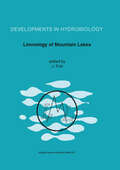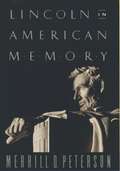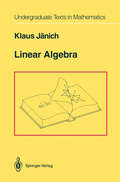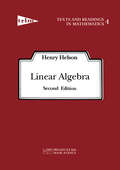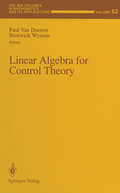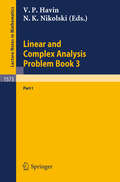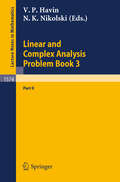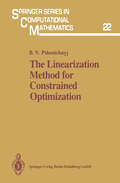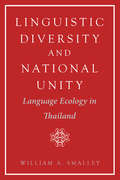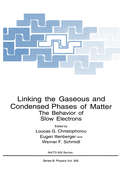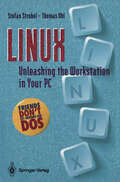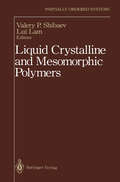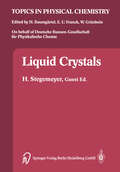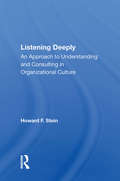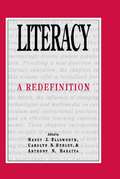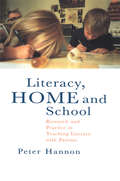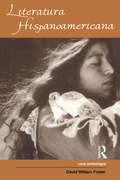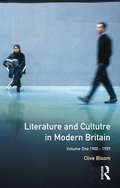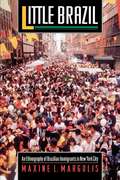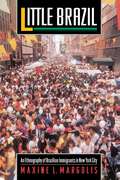- Table View
- List View
Limnology of Mountain Lakes (Developments in Hydrobiology #93)
by J. FottThis volume contains papers presented either in oral or poster form at the international symposium `Limnology of Mountain Lakes', held at Stará Lesná (Slovakia) between 1 and 7 July 1991. Several papers covered contributions from the fields of physical and chemical limnology, palaeolimnology, zooplankton, phytoplankton and phytobenthos, and bacteria. Acidification, a process affecting water chemistry and biota of many mountain lakes in Europe was dealt with also. A series of papers on the lakes in Sumava has highlighted different aspects of these lakes, which are in the last stage of acidification. Other geographical areas covered extensively were the Tatras and the Alps.
Lincoln in American Memory
by Merrill D. PetersonLincoln's death, like his life, was an event of epic proportions. When the president was struck down at his moment of triumph, writes Merrill Peterson, "sorrow--indescribable sorrow" swept the nation. After lying in state in Washington, Lincoln's body was carried by a special funeral train to Springfield, Illinois, stopping in major cities along the way; perhaps a million people viewed the remains as memorial orations rang out and the world chorused its sincere condolences. It was the apotheosis of the martyred President--the beginning of the transformation of a man into a mythic hero. In Lincoln in American Memory, historian Merrill Peterson provides a fascinating history of Lincoln's place in the American imagination from the hour of his death to the present. In tracing the changing image of Lincoln through time, this wide-ranging account offers insight into the evolution and struggles of American politics and society--and into the character of Lincoln himself. Westerners, Easterners, even Southerners were caught up in the idealization of the late President, reshaping his memory and laying claim to his mantle, as his widow, son, memorial builders, and memorabilia collectors fought over his visible legacy. Peterson also looks at the complex responses of blacks to the memory of Lincoln, as they moved from exultation at the end of slavery to the harsh reality of free life amid deep poverty and segregation; at more than one memorial event for the great emancipator, the author notes, blacks were excluded. He makes an engaging examination of the flood of reminiscences and biographies, from Lincoln's old law partner William H. Herndon to Carl Sandburg and beyond. Serious historians were late in coming to the topic; for decades the myth-makers sought to shape the image of the hero President to suit their own agendas. He was made a voice of prohibition, a saloon-keeper, an infidel, a devout Christian, the first Bull Moose Progressive, a military blunderer and (after the First World War) a military genius, a white supremacist (according to D.W. Griffith and other Southern admirers), and a touchstone for the civil rights movement. Through it all, Peterson traces five principal images of Lincoln: the savior of the Union, the great emancipator, man of the people, first American, and self-made man. In identifying these archetypes, he tells us much not only of Lincoln but of our own identity as a people.
Linear Algebra (Undergraduate Texts in Mathematics)
by Klaus JänichThis book covers the material of an introductory course in linear algebra. Topics include sets and maps, vector spaces, bases, linear maps, matrices, determinants, systems of linear equations, Euclidean spaces, eigenvalues and eigenvectors, diagonalization of self-adjoint operators, and classification of matrices. It contains multiple choice tests with commented answers.
Linear Algebra (Texts and Readings in Mathematics #4)
by Henry HelsonLinear Algebra is an important part of pure mathematics, and is needed for applications in every part of mathematics, natural science and economics. However, the applications are not so obvious as those of calculus. Therefore, one must study Linear Algebra as pure mathematics, even if one is only interested in applications. Most students find the subject difficult because it is abstract. Many texts try to avoid the difficulty by emphasizing calculations and suppressing the mathematical content of the subject. This text proceeds from the view that it is best to present the difficulties honestly, but as concisely and simply as possible. Although the text is shorter than others, all the material of a semester course is included. In addition, there are sections on least squares approximation and factor analysis; and a final chapter presents the matrix factorings that are used in Numerical Analysis.
Linear Algebra for Control Theory (The IMA Volumes in Mathematics and its Applications #62)
by Paul Van Dooren Bostwick WymanDuring the past decade the interaction between control theory and linear algebra has been ever increasing, giving rise to new results in both areas. As a natural outflow of this research, this book presents information on this interdisciplinary area. The cross-fertilization between control and linear algebra can be found in subfields such as Numerical Linear Algebra, Canonical Forms, Ring-theoretic Methods, Matrix Theory, and Robust Control. This book's editors were challenged to present the latest results in these areas and to find points of common interest. This volume reflects very nicely the interaction: the range of topics seems very wide indeed, but the basic problems and techniques are always closely connected. And the common denominator in all of this is, of course, linear algebra.This book is suitable for both mathematicians and students.
Linear and Complex Analysis Problem Book 3: Part 1 (Lecture Notes in Mathematics #1573)
by Victor P. Havin Nikolai K. NikolskiThe 2-volume book is an updated, reorganized and considerably enlarged version of the previous edition of the Research Problem Book in Analysis (LNM 1043), a collection familiar to many analysts, that has sparked off much research. This new edition, created in a joint effort by a large team of analysts, is, like its predecessor, a collection of unsolved problems of modern analysis designed as informally written mini-articles, each containing not only a statement of a problem but also historical and methodological comments, motivation, conjectures and discussion of possible connections, of plausible approaches as well as a list of references. There are now 342 of these mini- articles, almost twice as many as in the previous edition, despite the fact that a good deal of them have been solved!
Linear and Complex Analysis Problem Book 3: Part 2 (Lecture Notes in Mathematics #1574)
by Victor P. Havin Nikolai K. NikolskiThe 2-volume-book is an updated, reorganized and considerably enlarged version of the previous edition of the Research Problem Book in Analysis (LNM 1043), a collection familiar to many analysts, that has sparked off much research. This new edition, created in a joint effort by a large team of analysts, is, like its predecessor, a collection of unsolved problems of modern analysis designed as informally written mini-articles, each containing not only a statement of a problem but also historical and metho- dological comments, motivation, conjectures and discussion of possible connections, of plausible approaches as well as a list of references. There are now 342 of these mini- articles, almost twice as many as in the previous edition, despite the fact that a good deal of them have been solved!
The Linearization Method for Constrained Optimization (Springer Series in Computational Mathematics #22)
by Boris N. PshenichnyjTechniques of optimization are applied in many problems in economics, automatic control, engineering, etc. and a wealth of literature is devoted to this subject. The first computer applications involved linear programming problems with simp- le structure and comparatively uncomplicated nonlinear pro- blems: These could be solved readily with the computational power of existing machines, more than 20 years ago. Problems of increasing size and nonlinear complexity made it necessa- ry to develop a complete new arsenal of methods for obtai- ning numerical results in a reasonable time. The lineariza- tion method is one of the fruits of this research of the last 20 years. It is closely related to Newton's method for solving systems of linear equations, to penalty function me- thods and to methods of nondifferentiable optimization. It requires the efficient solution of quadratic programming problems and this leads to a connection with conjugate gra- dient methods and variable metrics. This book, written by one of the leading specialists of optimization theory, sets out to provide - for a wide readership including engineers, economists and optimization specialists, from graduate student level on - a brief yet quite complete exposition of this most effective method of solution of optimization problems.
Linguistic Diversity and National Unity: Language Ecology in Thailand
by William A. SmalleyUnlike other multi-ethnic nations, such as Myanmar and India, where official language policy has sparked bloody clashes, Thailand has maintained relative stability despite its eighty languages. In this study of the relations among politics, geography, and language, William A. Smalley shows how Thailand has maintained national unity through an elaborate social and linguistic hierarchy. Smalley contends that because the people of Thailand perceive their social hierarchy as the normal order, Standard Thai, spoken by members of the higher levels of society, prevails as the uncontested national language. By examining the hierarchy of Thailand's diverse languages and dialects in light of Thai history, education, culture, and religion, Smalley shows how Thailand has been able to keep its many ethnic groups at peace. Linguistic Diversity and National Unity explores the intricate relationship between language and power and the ways in which social and linguistic rank can be used to perpetuate order.
Linking the Gaseous and Condensed Phases of Matter: The Behavior of Slow Electrons (Nato Science Series B: #326)
by Loucas G. Christophorou Eugen Illenberger Werner F. SchmidtThe Advanced Study Institute (ASI) on "Linking the Gaseous and Condensed Phases of Matter: The Behavior of Slow Electrons" was held at Patras, Greece, September 5-18, 1993. The organizers of the Patras ASI felt that the study of the electronic properties of matter in various states of aggregation has advanced to a point where further progress required the interfacing of the phases of matter in order to find out and to understand how the microscopic and macroscopic properties of materials and processes change as we go from low pressure gas to the condensed phase. This approach is of foremost significance both from the point of view of basic research and of applications. Linking the electronic properties of the gaseous and condensed phases of matter is a fascinating new frontier of science embracing scientists not only from physics and chemistry but also from the life sciences and engineering. The Patras ASI brought together some of the world's foremost experts who work in the field of electronic properties of molecular gases, clusters, liquids, and solids. The thirty five lectures given at the meeting as well as the twenty nine poster papers presented and the formal and informal discussions that took place focused largely on the behavior of slow electrons in matter.
LINUX: Unleashing the Workstation in Your PC
by Stefan Strobel Thomas UhlUNIX achieved its widespread propagation, its penetration of the UNIX history university domain, and its reach into research and industry due to its early dissemination by AT&T to all interested parties at almost no cost and as source code. UNIX's present functionality emanated not just from AT&T developers but also from external developers who used the product and contributed their own further developments, which they then put at AT&T's disposal. (Consider the contributions of the University of California at Berkeley, for example.) With the rising commercialization of UNIX by AT&T (now by Novell) since 1983, such creative and cooperative further development became increasingly restricted, and UNIX source code today has become unaffordably expensive and scarcely accessible. Linux provides interested computer scientists and us"ers with a system that revives the old UNIX tradition: Linux is available for free, and everyone is heartily invited (but not obliged) to free & participatory contribute to its further development. Since Linux runs on PC systems, it has begun to penetrate the workrooms of many computer science students and computer freaks.
Liquid Crystalline and Mesomorphic Polymers (Partially Ordered Systems)
by Valery P. Shibaev Lui LamAmong the various new directions in modern polymer science, the design and investigation of liquid crystal (LC) polymers have been the ones growing most actively and fruitfully. In spite of that, the possible formation of an anisotropic LC phase was only demonstrated theoretically for the first time in the 1950s by Onsager [1] and Flory [2], and then experimentally verified in the studies with polypeptides solutions. In essence, the studies of these LC lyotropic systems did not deviate from the theme of purely academic interest. It was at the beginning of the 1970s that the experimental "explosion" occurred, when aromatic polyamides were synthesized and their ability to form LC solutions in certain very aggressive solvents was discovered. The search for practical applications of such LC systems was crowned with the successful creation of the new generation of ultrastrong high-modulus ther mostable fibers, such as the Kevlar, due to the high degree of order of the macromolecules in the anisotropic LC state. In fact, these investigations coincided with the swift emergence on the practical "scene" of thermotropic low-molar-mass liquid crystals, with the use of these materials in microelectronics and electro optics (figures and let ters indicators, displays in personal computers, and flat TV, etc.). Polymer scientists also began to develop methods of synthesizing thermotropic LC polymers by incorporating mesogenic fragments in the main (main-chain LC polymers) or side branchings of the macromolecules (side-chain or comb shaped polymers).
Liquid Crystals (Topics in Physical Chemistry #3)
by Ludwig Pohl D. Demus G. Pelzl Heino Finkelmann Karl Hiltrop Martin SchadtIn 1959, about 1400 compounds forming liquid crystalline phases were known; by 1992, this number had increased to about 50 000. In portable devices like wristwatches, pocket caculators, measuring instruments, and laptop computers the liquid crystal display technology has gained total acceptance and is on the way to encompass the market of colour TV screens. This development makes a volume devoted to liquid crystals in the series Topics in Physical Chemistry desirable. Following the concept of this series, an easy introduction to liquid crystals is given, enabling the reader to understand the basic problems of liquid crystals research and application. Because of the widespread field of different research activities in liquid crystals and applications, various competent authors have been involved in writing chapters on: - Phase types, structures, and chemistry of liquid crystals; - Thermodynamical behavior and physical properties of thermotropic liquid crystals; - Liquid crystalline polymers; - Lyotropic liquid crystals; - Application of liquid crystals in spectroscopy; - Application of liquid crystals in display technology.
Listening Deeply: An Approach To Understanding And Consulting In Organizational Culture
by Howard F SteinSo much in our society is based on the importance of doing, achieving, striving, intervening, and producing. In contrast, Listening Deeply attempts to re-establish listening and attentiveness toward others as the key to consulting with organizations. Professor Howard Stein uses his training in anthropology and psychology to shed light on organizational relationships and tensions. He shows how a consultant can safely allow emotionally charged issues to emerge so that healing can begin. Using brief and extended case examples from his own consulting practice, Stein illustrates his approach of creating a safe holding environment, in which members of an organization can express difficult emotions and learn to understand themselves and their colleagues better. He encourages consultants to use the self creatively and constructively to look beyond the obvious in interpreting messages from group members. Sometimes it is only through the consultants own emotional response that the root of the organizations problem becomes clear. Stein provides concrete examples that show the consultant how to listen for underlying themes and thoughtfully analyze both the text and subtext of an organizations culture. Through his cases, Stein demonstrates how the consultant can go beyond conventional problem-solving to promote healing, growth, and, ultimately, a better working environment.
Listening Deeply: An Approach To Understanding And Consulting In Organizational Culture (Advances In Organizational Psychodynamics Ser.)
by Howard F SteinSo much in our society is based on the importance of doing, achieving, striving, intervening, and producing. In contrast, Listening Deeply attempts to re-establish listening and attentiveness toward others as the key to consulting with organizations. Professor Howard Stein uses his training in anthropology and psychology to shed light on organizational relationships and tensions. He shows how a consultant can safely allow emotionally charged issues to emerge so that healing can begin. Using brief and extended case examples from his own consulting practice, Stein illustrates his approach of creating a safe holding environment, in which members of an organization can express difficult emotions and learn to understand themselves and their colleagues better. He encourages consultants to use the self creatively and constructively to look beyond the obvious in interpreting messages from group members. Sometimes it is only through the consultants own emotional response that the root of the organizations problem becomes clear. Stein provides concrete examples that show the consultant how to listen for underlying themes and thoughtfully analyze both the text and subtext of an organizations culture. Through his cases, Stein demonstrates how the consultant can go beyond conventional problem-solving to promote healing, growth, and, ultimately, a better working environment.
Literacy: A Redefinition
by Nancy J. Ellsworth Carolyn N. Hedley Anthony N. BarattaThe concepts of the past, centered more narrowly on traditional ways of learning to read and write, no longer suffice in a society that requires higher level skills from an increasingly diverse student population. Providing a new direction in literacy education, the chapters in this volume offer a revitalized perspective of literacy. They focus on the forms that literacy will take in the future, the influence of changing technologies and multimedia on curriculum and instructional practices, and on effective learning environments. These chapters incorporate the insights of researchers in several disciplines to examine ways of helping students develop the broad-based literacy skills they will need in order to participate fully in American society. Teachers, teacher educators, and others concerned with the future of nurturing and schooling will find challenging ideas for redefining instruction in literacy in this book.
Literacy: A Redefinition
by Nancy J. Ellsworth Carolyn N. Hedley Anthony N. BarattaThe concepts of the past, centered more narrowly on traditional ways of learning to read and write, no longer suffice in a society that requires higher level skills from an increasingly diverse student population. Providing a new direction in literacy education, the chapters in this volume offer a revitalized perspective of literacy. They focus on the forms that literacy will take in the future, the influence of changing technologies and multimedia on curriculum and instructional practices, and on effective learning environments. These chapters incorporate the insights of researchers in several disciplines to examine ways of helping students develop the broad-based literacy skills they will need in order to participate fully in American society. Teachers, teacher educators, and others concerned with the future of nurturing and schooling will find challenging ideas for redefining instruction in literacy in this book.
Literacy, Home and School: Research And Practice In Teaching Literacy With Parents
by Peter Hannon University of Sheffield.Parental involvement in the teaching of reading and writing has often lagged behind practice, though schools in many countries now recognise the importance of parental involvement. The ideas presented in this book offer new ways of thinking about parental involvement and should interest both researchers and practitioners. It relates the recent growth of involvement to broader considerations of the nature of literacy and historical exclusion of parents from the curriculum.; Descriptions are given of key findings from research into pre-school literacy work with parents and parents hearing children read, and a framework to underpin practice is offered. The author gives a critique of evaluation methods in the field and suggests how parental involvement should be evaluated together with a view of research findings to date and issues needing further study. The book concludes with an appraisal of what was learned from research and what needs further enquiry.
Literacy, Home and School: Research And Practice In Teaching Literacy With Parents
by Peter Hannon University of Sheffield.Parental involvement in the teaching of reading and writing has often lagged behind practice, though schools in many countries now recognise the importance of parental involvement. The ideas presented in this book offer new ways of thinking about parental involvement and should interest both researchers and practitioners. It relates the recent growth of involvement to broader considerations of the nature of literacy and historical exclusion of parents from the curriculum.; Descriptions are given of key findings from research into pre-school literacy work with parents and parents hearing children read, and a framework to underpin practice is offered. The author gives a critique of evaluation methods in the field and suggests how parental involvement should be evaluated together with a view of research findings to date and issues needing further study. The book concludes with an appraisal of what was learned from research and what needs further enquiry.
Literatura Hispanoamericana: Una Antologia - An Anthology
by David W. FosterThis Spanish-language anthology contains selections by 45 Latin-American authors. It is intended as a text for upper division Latin American literature survey courses. The anthology presumes a high level of linguistic command of Spanish, and it contains footnotes to allusions and cultural references, as well as words and phrases not found in standard bilingual dictionaries used in the US. Emphasis is on major 20th-century writers, while important works from colonial and 19th-century literature as also included. The diverse selections of Literature Hispanoamericana will enable students to have a more sustained exposure to major voices of Latin American literature than possible in anthologies built around fragments. By focusing on fewer authors but more significant selections from their writings, students will have a greater grasp of major canonical figures as well as emergent voices.
Literatura Hispanoamericana: Una Antologia - An Anthology
by David W. FosterThis Spanish-language anthology contains selections by 45 Latin-American authors. It is intended as a text for upper division Latin American literature survey courses. The anthology presumes a high level of linguistic command of Spanish, and it contains footnotes to allusions and cultural references, as well as words and phrases not found in standard bilingual dictionaries used in the US. Emphasis is on major 20th-century writers, while important works from colonial and 19th-century literature as also included. The diverse selections of Literature Hispanoamericana will enable students to have a more sustained exposure to major voices of Latin American literature than possible in anthologies built around fragments. By focusing on fewer authors but more significant selections from their writings, students will have a greater grasp of major canonical figures as well as emergent voices.
Literature and Culture in Modern Britain: 1900-1929
by Clive BloomThe first in a three-volume sequence, this book covers the period between 1900 and 1929, providing a perceptive and thorough analysis of British literature within its historical, cultural and artistic context. It identifies the crucial, interwoven relationships between literature and the visual arts, modern poetry, popular fiction, journalism, cinema, music and radio. Much factual detail and a literary chronology guide the reader through the text.
Literature and Culture in Modern Britain: 1900-1929
by Clive BloomThe first in a three-volume sequence, this book covers the period between 1900 and 1929, providing a perceptive and thorough analysis of British literature within its historical, cultural and artistic context. It identifies the crucial, interwoven relationships between literature and the visual arts, modern poetry, popular fiction, journalism, cinema, music and radio. Much factual detail and a literary chronology guide the reader through the text.
Little Brazil: An Ethnography of Brazilian Immigrants in New York City
by Maxine L. MargolisWalking west on 46th Street in Manhattan, just three blocks from Rockefeller Center, one passes Brazilian restaurants, the office of New York's Brazilian newspaper, a Brazilian travel agency, a business that sends remittances and wires flowers to Brazil, and a store that sells Brazilian food products, magazines, newspapers, videos, and tapes. These businesses are the tip of an ethnic iceberg, an unseen minority estimated to number some 80,000 to 100,000 Brazilians in the New York metropolitan area alone. Despite their numbers, the lives of these people remain largely hidden to scholars and the public alike. Now Maxine L. Margolis remedies this neglect with a fascinating and accessible account of the lives of New York's Brazilians.Showing that these immigrants belie American stereotypes, Margolis reveals that they are largely from the middle strata of Brazilian society: many, in fact, have university educations. Not driven by dire poverty or political repression, they are fleeing from chaotic economic conditions that prevent them from maintaining amiddle-class standard of living in Brazil. But despite their class origin and education, with little English and no work papers, many are forced to take menial jobs after their arrival in the United States. Little Brazil is not an insentient statistical portrait of this population writ large, but a nuanced account that captures what it is like to be a new immigrant in this most cosmopolitan of world cities.
Little Brazil: An Ethnography of Brazilian Immigrants in New York City
by Maxine L. MargolisWalking west on 46th Street in Manhattan, just three blocks from Rockefeller Center, one passes Brazilian restaurants, the office of New York's Brazilian newspaper, a Brazilian travel agency, a business that sends remittances and wires flowers to Brazil, and a store that sells Brazilian food products, magazines, newspapers, videos, and tapes. These businesses are the tip of an ethnic iceberg, an unseen minority estimated to number some 80,000 to 100,000 Brazilians in the New York metropolitan area alone. Despite their numbers, the lives of these people remain largely hidden to scholars and the public alike. Now Maxine L. Margolis remedies this neglect with a fascinating and accessible account of the lives of New York's Brazilians.Showing that these immigrants belie American stereotypes, Margolis reveals that they are largely from the middle strata of Brazilian society: many, in fact, have university educations. Not driven by dire poverty or political repression, they are fleeing from chaotic economic conditions that prevent them from maintaining amiddle-class standard of living in Brazil. But despite their class origin and education, with little English and no work papers, many are forced to take menial jobs after their arrival in the United States. Little Brazil is not an insentient statistical portrait of this population writ large, but a nuanced account that captures what it is like to be a new immigrant in this most cosmopolitan of world cities.
